You can modify workouts for any mobility challenge by adapting exercises to your current range of motion and physical capabilities. Use resistance bands, stability balls, and light weights to create effective alternatives. Chair-based exercises like seated presses and leg lifts build strength without standing, while wall-supported movements provide stability for standing workouts. Focus on gentle progressions, proper form, and consistent practice to maintain cardiovascular health and muscle tone. These proven strategies will transform your fitness approach.
Understanding Mobility Limitations and Their Impact on Fitness
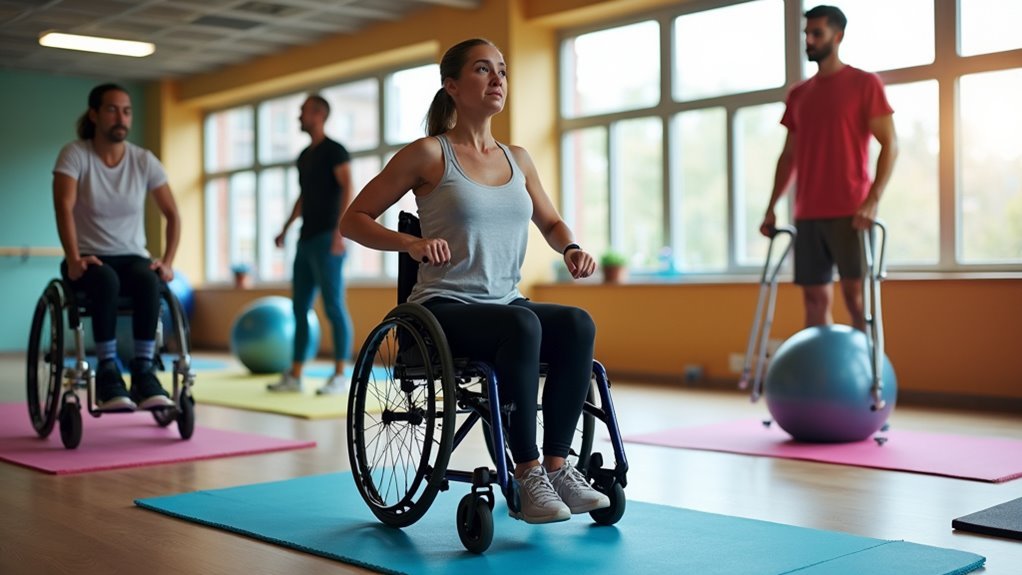
When mobility limitations affect your body, they create a cascade of challenges that extend far beyond simple movement restrictions. Your joints lose their full range of motion, forcing you to develop compensatory movement patterns that dramatically increase your injury risk.
These limitations, whether caused by age, injury, or medical conditions, directly impact your ability to perform daily activities and exercise effectively.
Your fitness suffers as decreased strength, balance, and stability make physical activities more challenging. Without proper modifications, you’ll likely develop muscle imbalances and postural problems that further compromise your physical performance and potentially lead to chronic pain.
Understanding exactly how your specific mobility limitations affect your body is essential for creating safe, effective workout modifications that’ll improve your functional fitness and overall quality of life.
Essential Equipment and Tools for Modified Workouts
The right equipment transforms your modified workout from a struggle into an effective fitness solution.
Resistance bands offer versatile strength training options with adjustable resistance levels that adapt to your specific mobility needs. You’ll find stability balls invaluable for enhancing core strength and balance while providing stable surfaces for seated or supported movements.
Adaptable resistance bands and stability balls provide essential support for strength training and balance work tailored to individual mobility requirements.
A foam roller becomes essential for myofascial release, helping you alleviate muscle tightness and improve overall function.
Dumbbells and kettlebells enable progressive resistance training that’s easily adjustable to your strength level and mobility requirements.
Don’t overlook exercise mats – they’re vital for creating comfortable, safe surfaces during floor-based mobility exercises.
These tools work together to guarantee you can perform effective modified workouts regardless of your mobility challenges.
Chair-Based Exercise Modifications for Upper and Lower Body
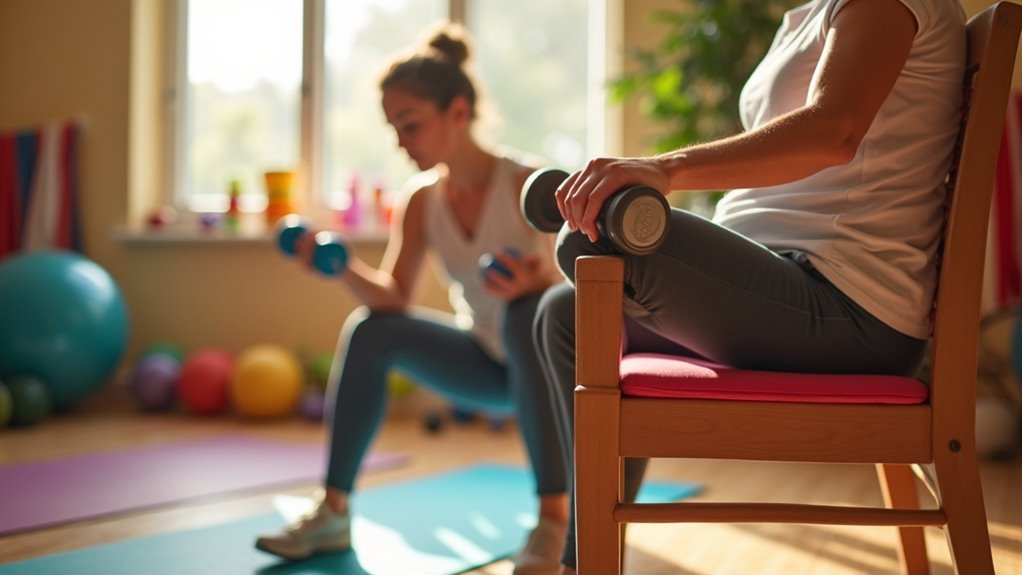
Since mobility limitations don’t have to derail your fitness goals, chair-based exercises offer a powerful solution that targets every major muscle group while keeping you safely seated.
You’ll strengthen your upper body with seated overhead presses and arm raises, improving shoulder and arm range of motion without standing requirements. For your lower body, seated leg lifts and ankle pumps effectively build leg strength while enhancing circulation and reducing joint stress.
Adding resistance bands transforms these movements into progressive strength training sessions, increasing intensity as you improve.
You’ll notice enhanced muscle tone, better balance, and increased functional independence through consistent practice. These modifications prove that effective workouts don’t require complex equipment or full mobility—just commitment to moving within your capabilities.
Standing Exercise Alternatives for Limited Range of Motion
You can shift from seated workouts to standing exercises that accommodate your limited range of motion while still building strength and stability.
Chair-based movement modifications allow you to use a chair or wall for support while performing exercises like squats, calf raises, and hip abductions.
Seated strength training principles apply to standing workouts too—you’ll focus on controlled movements within your comfortable range rather than forcing full motion.
Chair-Based Movement Modifications
When mobility challenges limit your ability to perform traditional standing exercises, chair-based modifications offer an effective pathway to maintain strength, flexibility, and cardiovascular health.
Chair-based exercises provide safe alternatives that don’t require standing while delivering powerful results.
Transform your seated position into a fitness opportunity with these modifications:
- Seated leg lifts and arm raises – Strengthen core and limb muscles through controlled movements
- Resistance band training – Target specific muscle groups with adjustable tension while remaining seated
- Chair aerobics routines – Elevate heart rate through rhythmic upper body movements and seated cardio
- Seated stretches and twists – Improve flexibility with forward bends and torso rotations
These chair-based exercises accommodate limited mobility while building confidence and independence in your fitness journey.
Seated Strength Training
Countless standing exercises can be transformed into powerful seated alternatives that deliver the same strength-building benefits without requiring full mobility. Seated strength training provides stability while minimizing fall risks, making it perfect for individuals with limited range of motion. You’ll target major muscle groups effectively using dumbbells, resistance bands, and functional movements.
| Exercise Type | Equipment | Target Muscles |
|---|---|---|
| Seated Press | Dumbbells | Shoulders, Arms |
| Leg Extensions | Body Weight | Quadriceps |
| Seated Rows | Resistance Bands | Back, Biceps |
| Lateral Raises | Light Weights | Deltoids |
| Tricep Extensions | Dumbbells | Triceps |
These modifications help improve muscle function while maintaining joint health. You’ll enhance muscle tone, boost daily activity performance, and experience improved overall well-being through consistent seated strength training routines.
Floor Exercise Adaptations for Joint and Movement Restrictions
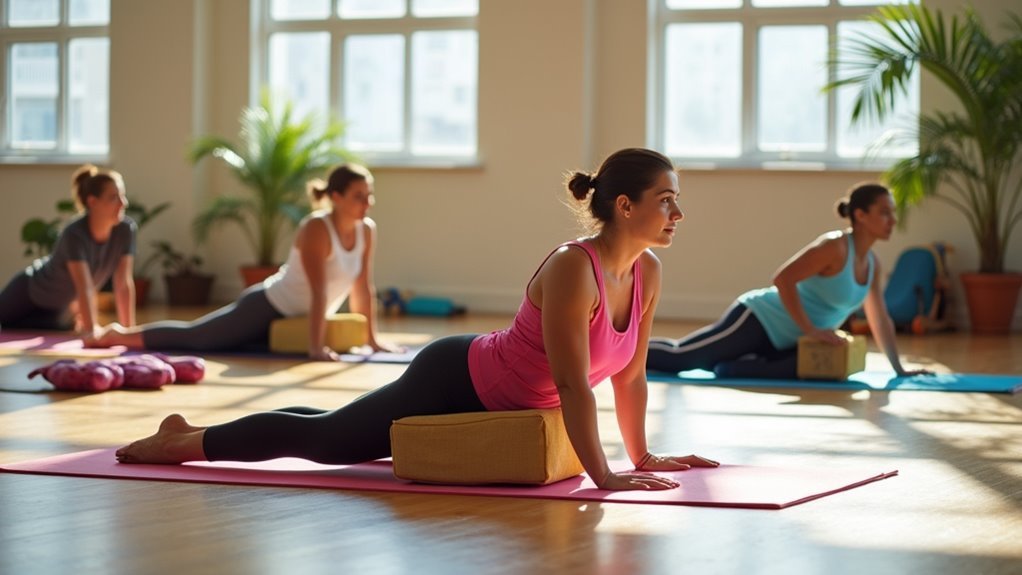
Although traditional floor exercises can seem impossible with joint restrictions or movement limitations, smart adaptations transform these movements into accessible strength-building opportunities.
You can overcome mobility challenges by modifying your approach and environment.
Consider these practical adaptations for floor exercises:
- Elevated surface modifications – Perform exercises on your bed or a low table to eliminate the strain of getting up and down from the floor.
- Wall-supported movements – Use walls for modified push-ups or wall sits, providing stability and confidence during workouts.
- Resistance band integration – Add controlled resistance while maintaining joint-friendly movements that accommodate your range of motion.
- Stability ball support – Incorporate seated ball exercises to strengthen your core while maintaining proper support for joint restrictions.
Cardiovascular Workout Modifications for All Mobility Levels
You don’t need to abandon cardiovascular exercise because of mobility limitations.
Chair-based cardio workouts let you perform effective upper body movements and aerobic exercises while seated, making heart-healthy activity accessible regardless of your mobility level.
Water exercises offer another excellent option, as the buoyancy reduces joint stress while providing resistance for a complete cardiovascular workout.
Chair-Based Cardio Options
When you’re dealing with mobility challenges, chair-based cardio exercises offer an effective way to maintain cardiovascular health without compromising your stability or comfort.
These workouts provide excellent options for limited mobility situations while delivering impressive cardiovascular benefits.
Chair-based cardio routines can give you a thorough full-body workout that targets major muscle groups:
- Seated marching – Lift your knees alternately while pumping your arms vigorously
- Dynamic arm circles – Create large, energetic circles forward and backward
- Resistance band pulls – Use bands for chest presses and rowing motions
- Chair dancing – Move your upper body rhythmically to upbeat music
You’ll improve heart health, boost circulation, and enhance endurance without joint stress.
These adaptable exercises help you meet weekly cardio recommendations regardless of your mobility level.
Water Exercise Benefits
While chair-based exercises excel at home workouts, water exercises take cardiovascular training to another level by creating the perfect environment for people with mobility challenges. Water’s buoyancy supports your body weight, reducing joint pressure while allowing full range of motion. You’ll find water aerobics improves cardiovascular endurance, muscle strength, and flexibility simultaneously.
| Benefit | Impact | Result |
|---|---|---|
| Buoyancy Support | Reduces joint strain | Pain-free movement |
| Resistance Training | Builds muscle strength | Improved stability |
| Balance Enhancement | Prevents falls | Better coordination |
| Low-Impact Environment | Protects joints | Safe exercise |
| Customizable Intensity | Adjustable difficulty | Personal progress |
Water workouts easily adapt with resistance tools like dumbbells or noodles, letting you target specific muscle groups while building balance and coordination.
Strength Training Adaptations Using Resistance Bands and Light Weights
Although traditional weightlifting might seem challenging with mobility limitations, resistance bands and light weights offer excellent alternatives that’ll help you build strength safely and effectively. These tools provide adjustable resistance levels that minimize joint strain while maximizing muscle activation.
Strength training with resistance bands addresses mobility challenges through accessible exercises that accommodate your specific needs. You can perform movements from seated or supported positions, maintaining stability while building functional strength.
Resistance bands make strength training accessible for everyone, allowing effective workouts from seated positions while building functional strength safely.
Picture yourself performing these adaptations:
- Seated shoulder presses with light dumbbells while maintaining proper back support
- Banded rows from your chair, pulling the resistance band toward your chest
- Lateral raises using bands attached to a stable surface
- Leg extensions with bands wrapped around your ankles
Gradually increasing resistance and focusing on proper form will lead to significant improvements in your mobility and overall physical performance.
Balance and Stability Exercises for Enhanced Mobility
You’ll build a solid foundation for enhanced mobility by mastering core stability fundamentals that engage your deep abdominal and back muscles.
Single limb training challenges your proprioception while strengthening stabilizing muscles that support everyday movements.
Progressive balance challenges gradually increase difficulty, allowing you to safely advance from basic static holds to dynamic movements that mirror real-world activities.
Core Stability Fundamentals
Foundation matters when it comes to mobility, and your core serves as that essential base for every movement you make. Core stability strengthens deep abdominal muscles that stabilize your pelvis and spine, helping you improve mobility while reducing strain on joints during daily activities.
Training your core 2-3 times weekly will reduce injury risk and enhance functional movement patterns.
Focus on these fundamental exercises:
- Planks – Hold steady positions that engage your entire core system
- Bird-dogs – Extend opposite arm and leg while maintaining spinal alignment
- Side bridges – Target lateral core muscles for thorough stability
- Single-leg stands – Challenge balance while strengthening stabilizing muscles
These exercises improve coordination and proprioception, creating a stronger foundation that supports better posture and enhanced athletic performance across all activities.
Single Limb Training
Building on your core foundation, single limb training takes your stability work to the next level by forcing each side of your body to function independently. This approach directly targets muscle imbalances while engaging your core and enhancing proprioception—your body’s awareness of position in space.
Single limb training challenges your coordination through exercises like single-leg deadlifts and lateral lunges. These movements require greater control and improve range of motion, particularly in your hips and ankles.
You’ll develop better joint function while reducing injury risk. When you train one leg at a time, you’re not just building strength—you’re enhancing agility, reaction time, and overall athletic performance.
Regular practice leads to significant mobility improvements, making dynamic movements more fluid and controlled for daily activities.
Progressive Balance Challenges
While single limb training builds unilateral strength, progressive balance challenges add an essential layer of instability that transforms simple movements into extensive stability workouts.
These balance exercises enhance proprioception—your body’s ability to sense its position in space—creating stronger neural pathways between your brain and muscles during mobility training.
Start with these progressive challenges:
- Single-leg stands: Begin with eyes open, progress to eyes closed, then add head movements
- Stability ball exercises: Sit, kneel, or perform planks on an unstable surface
- Lateral lunges: Step sideways while maintaining control and core engagement
- Balance board activities: Rock forward, backward, and side-to-side while standing
You’ll develop coordination, reduce fall risk, and improve athletic performance while building the stability foundation essential for all movement patterns.
Recovery and Gentle Movement Techniques
After completing your modified workout, your body needs intentional recovery strategies that work with your mobility challenges rather than against them.
Recovery becomes even more essential when you’re managing physical limitations, making gentle movement techniques vital for maintaining progress without setbacks.
When working within physical limitations, prioritizing gentle recovery methods prevents setbacks and ensures sustainable fitness progress over time.
Incorporate mobility exercises like gentle stretching to reduce muscle soreness and enhance relaxation.
Low-impact activities such as swimming or walking maintain cardiovascular health while minimizing strain on vulnerable areas.
Consider tai chi or yoga for improved flexibility, balance, and stress reduction through mindful movement.
Active recovery through light cycling or walking increases blood flow, helping remove metabolic waste and accelerating healing.
Don’t overlook foam rolling or self-myofascial release techniques—they’ll alleviate tension, improve range of motion, and support your recovery following any physical activity.
Building a Sustainable Modified Exercise Routine
Recovery techniques set the foundation, but creating a workout routine you can maintain long-term requires strategic planning that adapts to your unique mobility needs.
Building an effective exercise routine starts with professional guidance to guarantee you’re targeting the right areas safely.
Your sustainable mobility work should include:
- Swimming through crystal-clear pool waters – Low-impact cardio that supports your body while building endurance
- Gentle resistance band stretches in morning sunlight – Adjustable strength training that grows with your progress
- Flowing yoga poses on a soft mat – Joint-specific mobility exercises that maintain flexibility
- Consistent weekly sessions marked on your calendar – 150 minutes of moderate activity spread across structured days
Track your progress and adjust intensity as your mobility evolves, guaranteeing your exercise routine remains both challenging and achievable.
Frequently Asked Questions
How Can Exercise Correct or Modify Mobility Issues?
You can correct mobility issues by performing targeted exercises that strengthen stabilizing muscles, improve joint range of motion, and reduce stiffness through dynamic stretches and progressive mobility training tailored to your specific limitations.
What Exercises Are Good for People With Mobility Problems?
You’ll benefit from low-impact swimming, chair exercises like seated marches, gentle yoga, resistance band training, and isometric muscle contractions. These options won’t stress your joints while building strength and flexibility.
What Workouts Are Best for Mobility?
You’ll benefit most from dynamic mobility circuits featuring multi-joint movements like World’s Greatest Stretch, Cossack Squats, and 90/90 Hip Switches. Include spinal exercises like Cat Cows and resistance band work for thorough joint health improvement.
What Are Examples of Mobility Tasks?
You’ll benefit from dynamic stretching like World’s Greatest Stretch, 90/90 Hip Switches, Cat-Cow movements, Downward Dog Hip Openers, and Cossack Squats. These tasks target different areas while improving flexibility.
In Summary
You’ve learned how to adapt any workout to match your unique mobility needs. Whether you’re using chairs, resistance bands, or modified floor exercises, you’re now equipped to stay active regardless of physical limitations. Remember, consistency matters more than intensity. Start slowly, listen to your body, and gradually build your routine. Your fitness journey doesn’t stop because of mobility challenges—it just takes a different, equally valuable path forward.

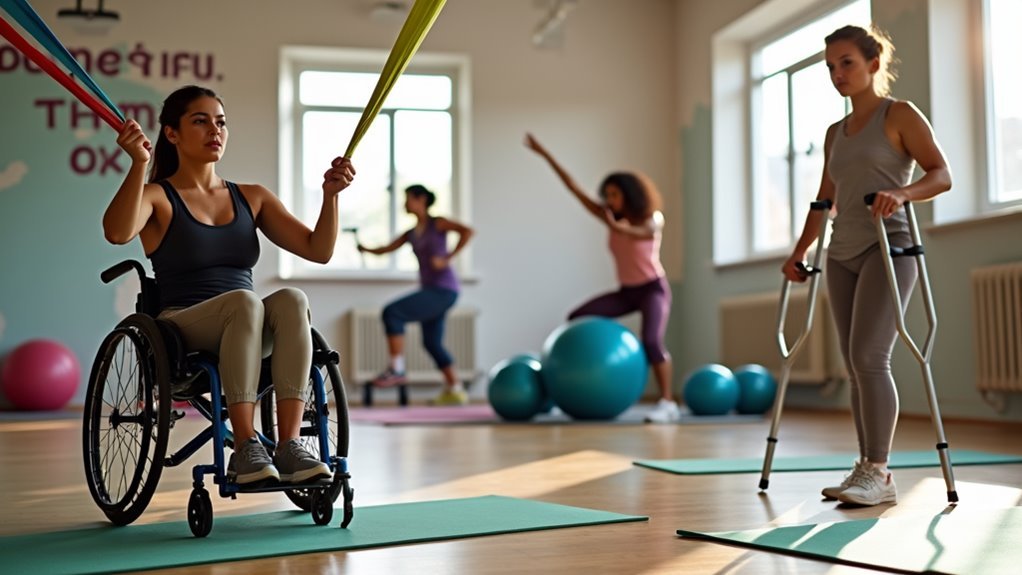
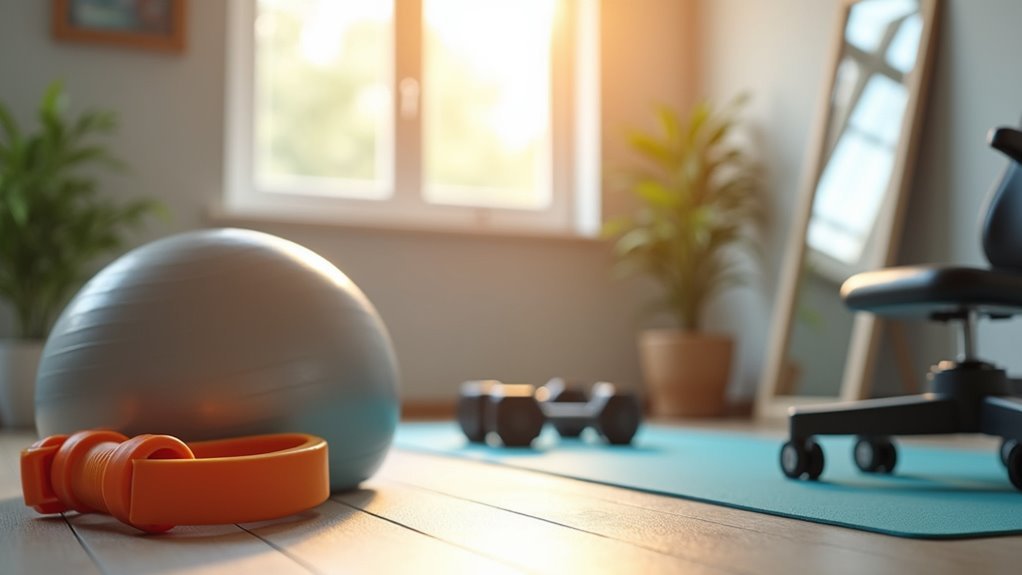
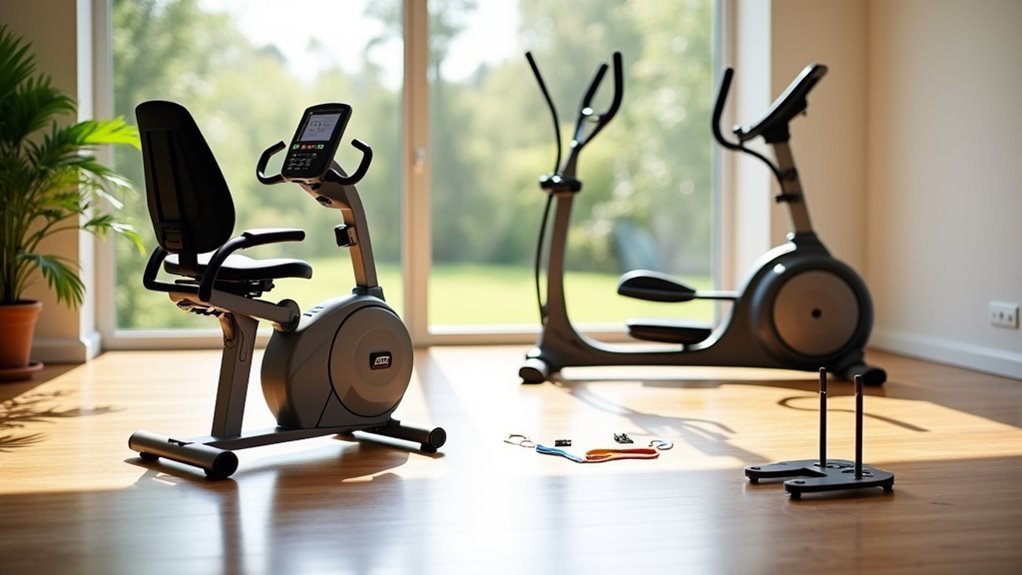
Leave a Reply